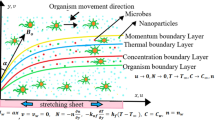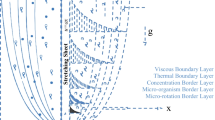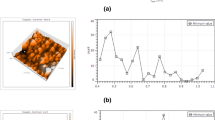Abstract
The nanoscale photothermal effect and the optofluidic convection around plasmonic nanoparticles drive the application of such nanoparticles in micro-environment. In this work, heat transfer and fluid flow around Au nanospheres and nanorods in water medium under continuous and pulsed wave laser irradiance was investigated using an FEM based numerical framework. Au nanospheres of a wide range of diameter: 40 nm ≤ Diameter (D) ≤ 180 nm and relatively large nanorods (diameter: 50 nm) with varying aspect ratio (1 ≤ Aspect ratio (A) ≤ 5) and orientation (0° ≤ θ ≤ 90°, ϕ = 0°, 90°) with respect to the incident EM radiation were investigated for continuous wave (CW) and pulsed wave laser. It was found that although nanorods can attain much higher temperature than nanospheres, orientation of a nanorod is an important factor to be carefully considered in applications. In micro-scale spherical and hemispherical confinements (diameter < 14.4 μm), the convective velocity fields around nanoparticles is in the order of 10–9 m/s, with only a weak effect of the slip or no-slip boundary condition on the confining walls. Importantly, the size of the confinement has a strong effect leading to an order of magnitude stronger convection for 14.4 μm (diameter) spherical confinement as compared to 3.6 μm confinement. Additionally close proximity of the nanoparticles to the confining walls strongly reduces (by an order of magnitude) the convective currents. The results reported herein provides important insights for the use of photothermal nanoparticles in microscale confined space (e.g. cellular environment) for applications such as optical tweezers, photoporation, etc.
Graphical Abstract












Similar content being viewed by others
Availability of Data and Materials
Not applicable.
References
Heinemann D, Kalies S, Schomaker M, Ertmer W, Escobar HM, Meyer H, Ripken T (2014) Delivery of proteins to mammalian cells via gold nanoparticle mediated laser transfection. Nanotechnology 25:245101. https://doi.org/10.1088/0957-4484/25/24/245101
Zhao J, Nguyen SC, Ye R, Ye B, Weller H, Somorjai GA, Alivisatos AP, Toste FD (2017) A comparison of photocatalytic activities of gold nanoparticles following plasmonic and interband excitation and a strategy for harnessing interband hot carriers for solution phase photocatalysis. ACS Cent Sci 3:482–488. https://doi.org/10.1021/acscentsci.7b00122
Hamad-Schifferli K, Schwartz JJ, Santos AT, Zhang S, Jacobson JM (2002) Remote electronic control of DNA hybridization through inductive coupling to an attached metal nanocrystal antenna. Nature 415:152–155. https://doi.org/10.1038/415152a
Wang M, Zhao C, Miao X, Zhao Y, Rufo J, Liu YJ, Huang TJ, Zheng Y (2015) Plasmofluidics: Merging light and fluids at the micro-/nanoscale. Small 11:4423–4444. https://doi.org/10.1002/smll.201500970
Wayteck L, Xiong R, Braeckmans K, De Smedt SC, Raemdonck K (2017) Comparing photoporation and nucleofection for delivery of small interfering RNA to cytotoxic T cells. J Control Release 267:154–162. https://doi.org/10.1016/j.jconrel.2017.08.002
Furube A, Hashimoto S (2017) Insight into plasmonic hot-electron transfer and plasmon molecular drive: new dimensions in energy conversion and nanofabrication. NPG Asia Mater 9:e454–e454. https://doi.org/10.1038/am.2017.191
Baffou G (2017) Thermoplasmonics: Heating Metal Nanoparticles Using Light, 1st edition, Cambridge University Press, Cambridge. United Kingdom; New York, NY
Chaabani W, Chehaidar A, Plain J (2016) Comparative theoretical study of the optical properties of silicon/gold, silica/gold core/shell and gold spherical nanoparticles. Plasmonics 11:1525–1535. https://doi.org/10.1007/s11468-016-0206-5
Jain PK, Lee KS, El-Sayed IH, El-Sayed MA (2006) Calculated absorption and scattering properties of gold nanoparticles of different size, shape, and composition: Applications in biological imaging and biomedicine. J Phys Chem B 110:7238–7248. https://doi.org/10.1021/jp057170o
Cortie MB, Xu X, Chowdhury H, Zareie H, Smith G (2005) Plasmonic heating of gold nanoparticles and its exploitation. In: Smart Structures, Devices, and Systems II, SPIE, pp. 565–573. https://doi.org/10.1117/12.582207
Petrov YV (2005) Energy exchange between the lattice and electrons in a metal under femtosecond laser irradiation. Laser Part Beams 23:283–289. https://doi.org/10.1017/S0263034605050391
Sassaroli E, Li KCP, O’Neill BE (2009) Numerical investigation of heating of a gold nanoparticle and the surrounding microenvironment by nanosecond laser pulses for nanomedicine applications. Phys Med Biol 54:5541. https://doi.org/10.1088/0031-9155/54/18/013
Hirsch LR, Stafford RJ, Bankson JA, Sershen SR, Rivera B, Price RE, Hazle JD, Halas NJ, West JL (2003) Nanoshell-mediated near-infrared thermal therapy of tumors under magnetic resonance guidance. Proc Natl Acad Sci 100:13549–13554. https://doi.org/10.1073/pnas.2232479100
Dhiman M, Maity A, Das A, Belgamwar R, Chalke B, Lee Y, Sim K, Nam J-M, Polshettiwar V (2019) Plasmonic colloidosomes of black gold for solar energy harvesting and hotspots directed catalysis for CO2 to fuel conversion. Chem Sci 10:6594–6603. https://doi.org/10.1039/C9SC02369K
Liu X, Shan G, Yu J, Yang W, Ren Z, Wang X, Xie X, Chen H, Chen X (2017) Laser heating of metallic nanoparticles for photothermal ablation applications. AIP Adv 7:025308. https://doi.org/10.1063/1.4977554
Neumann O, Feronti C, Neumann AD, Dong A, Schell K, Lu B, Kim E, Quinn M, Thompson S, Grady N, Nordlander P, Oden M, Halas NJ (2013) Compact solar autoclave based on steam generation using broadband light-harvesting nanoparticles. Proc Natl Acad Sci 110:11677–11681. https://doi.org/10.1073/pnas.1310131110
Guo A, Fu Y, Wang G, Wang X (2017) Diameter effect of gold nanoparticles on photothermal conversion for solar steam generation. RSC Adv 7:4815–4824. https://doi.org/10.1039/C6RA26979F
Liu Y, Liu Z, Huang Q, Liang X, Zhou X, Fu H, Wu Q, Zhang J, Xie W (2019) A high-absorption and self-driven salt-resistant black gold nanoparticle-deposited sponge for highly efficient, salt-free, and long-term durable solar desalination. J Mater Chem A 7:2581–2588. https://doi.org/10.1039/C8TA10227A
Xiong R, Samal SK, Demeester J, Skirtach AG, De Smedt SC, Braeckmans K (2016) Laser-assisted photoporation: fundamentals, technological advances and applications. Adv Phys X 1:596–620. https://doi.org/10.1080/23746149.2016.1228476
Xiong R, Raemdonck K, Peynshaert K, Lentacker I, De Cock I, Demeester J, De Smedt SC, Skirtach AG, Braeckmans K (2014) Comparison of gold nanoparticle mediated photoporation: Vapor nanobubbles outperform direct heating for delivering macromolecules in live cells. ACS Nano 8:6288–6296. https://doi.org/10.1021/nn5017742
Qiu TQ, Tien CL (1992) Short-pulse laser heating on metals. Int J Heat Mass Transf 35:719–726. https://doi.org/10.1016/0017-9310(92)90131-B
Baffou G, Quidant R, García de Abajo FJ (2010) Nanoscale control of optical heating in complex plasmonic systems. ACS Nano 4:709–716. https://doi.org/10.1021/nn901144d
Baffou G, Berto P, Bermúdez Ureña E, Quidant R, Monneret S, Polleux J, Rigneault H (2013) Photoinduced heating of nanoparticle arrays. ACS Nano 7:6478–6488. https://doi.org/10.1021/nn401924n
Baffou G, Quidant R, Girard C (2010) Thermoplasmonics modeling: A Green’s function approach. Phys Rev B 82:165424. https://doi.org/10.1103/PhysRevB.82.165424
Baffou G, Rigneault H (2011) Femtosecond-pulsed optical heating of gold nanoparticles. Phys Rev B 84:035415. https://doi.org/10.1103/PhysRevB.84.035415
Baffou G, Quidant R (2013) Thermo-plasmonics: using metallic nanostructures as nano-sources of heat. Laser Photonics Rev 7:171–187. https://doi.org/10.1002/lpor.201200003
Donner JS, Baffou G, McCloskey D, Quidant R (2011) Plasmon-assisted optofluidics. ACS Nano 5:5457–5462. https://doi.org/10.1021/nn200590u
Norton SJ, Vo-Dinh T (2016) Photothermal effects of plasmonic metal nanoparticles in a fluid. J Appl Phys 119:083105. https://doi.org/10.1063/1.4942623
Alali F, Karampelas IH, Kim YH, Furlani EP (2013) Photonic and thermofluidic analysis of colloidal plasmonic nanorings and nanotori for pulsed-laser photothermal applications. J Phys Chem C 117:20178–20185. https://doi.org/10.1021/jp406986y
Ren Y, Chen Q, Qi H, Ruan L, Dai J (2018) Phase transition induced by localized surface plasmon resonance of nanoparticle assemblies. Int J Heat Mass Transf 127:244–252. https://doi.org/10.1016/j.ijheatmasstransfer.2018.07.049
Winterer F, Maier CM, Pernpeintner C, Lohmüller T (2018) Optofluidic transport and manipulation of plasmonic nanoparticles by thermocapillary convection. Soft Matter 14:628–634. https://doi.org/10.1039/C7SM01863K
Zheng J, Xing X, Yang J, Shi K, He S (2018) Hybrid optofluidics and three-dimensional manipulation based on hybrid photothermal waveguides. NPG Asia Mater 10:340–351. https://doi.org/10.1038/s41427-018-0026-5
Choi C-H, Westin KJA, Breuer KS (2003) Apparent slip flows in hydrophilic and hydrophobic microchannels. Phys Fluids 15:2897–2902. https://doi.org/10.1063/1.1605425
Neto C, Evans DR, Bonaccurso E, Butt H-J, Craig VSJ (2005) Boundary slip in Newtonian liquids: a review of experimental studies. Rep Prog Phys 68:2859. https://doi.org/10.1088/0034-4885/68/12/R05
Maali A, Bhushan B (2012) Measurement of slip length on superhydrophobic surfaces. Philos Trans Royal Soc A Math Phys Eng Sci 370:2304–2320. https://doi.org/10.1098/rsta.2011.0505
Zhang X, Harrison S (2004) A laboratory observation of the surface temperature and velocity distributions on a wavy and windy air–water interface. Phys Fluids 16:L5–L8. https://doi.org/10.1063/1.1631813
Luo G, Du L, Wang Y, Lu Y, Xu J (2011) Controllable preparation of particles with microfluidics. Particuology 9:545–558. https://doi.org/10.1016/j.partic.2011.06.004
Uson L, Sebastian V, Arruebo M, Santamaria J (2016) Continuous microfluidic synthesis and functionalization of gold nanorods. Chem Eng J 285:286–292. https://doi.org/10.1016/j.cej.2015.09.103
Hatef A, Fortin-Deschênes S, Boulais E, Lesage F, Meunier M (2015) Photothermal response of hollow gold nanoshell to laser irradiation: Continuous wave, short and ultrashort pulse. Int J Heat Mass Transf 89:866–871. https://doi.org/10.1016/j.ijheatmasstransfer.2015.05.071
Chen X, Chen Y, Yan M, Qiu M (2012) Nanosecond photothermal effects in plasmonic nanostructures. ACS Nano 6:2550–2557. https://doi.org/10.1021/nn2050032
Borah R, Gupta S, Mishra L, Chhabra RP (2020) Heating of liquid foods in cans: Effects of can geometry, orientation, and food rheology. J Food Process Eng 43:e13420. https://doi.org/10.1111/jfpe.13420
Gray DD, Giorgini A (1976) The validity of the boussinesq approximation for liquids and gases. Int J Heat Mass Transf 19:545–551. https://doi.org/10.1016/0017-9310(76)90168-X
Tritton DJ, Tritton DJ (1988) Physical Fluid Dynamics, 2nd edn. Oxford University Press, Oxford, New York, Second Edition
Johnson PB, Christy RW (1972) Optical constants of the noble metals. Phys Rev B 6:4370–4379. https://doi.org/10.1103/PhysRevB.6.4370
Reddy H, Guler U, Kildishev AV, Boltasseva A, Shalaev VM (2016) Optical properties of gold thin films at elevated temperatures. Conf Lasers Electro-Opt (CLEO) 2016:1–2
Zonta F, Marchioli C, Soldati A (2012) Modulation of turbulence in forced convection by temperature-dependent viscosity. J Fluid Mech 697:150–174. https://doi.org/10.1017/jfm.2012.67
Sowa M, Typańska D (2014) Comparison of time-stepping methods for transient magnetic field computations in COMSOL Multiphysics. Poznan Univ Technol Acad J Electr Eng 77. http://yadda.icm.edu.pl/baztech/element/bwmeta1.element.baztech-05bd3e42-c95e-45fc-bcdd-9d928b794ec0 (Accessed 4 Apr 2023)
Borah R, Ninakanti R, Bals S, Verbruggen SW (2022) Plasmon resonance of gold and silver nanoparticle arrays in the Kretschmann (attenuated total reflectance) vs. direct incidence configuration. Sci Rep 12:15738. https://doi.org/10.1038/s41598-022-20117-7
Borah R, Smets J, Ninakanti R, Tietze ML, Ameloot R, Chigrin DN, Bals S, Lenaerts S, Verbruggen SW (2022) Self-assembled ligand-capped plasmonic Au nanoparticle films in the kretschmann configuration for sensing of volatile organic compounds. ACS Appl Nano Mater 5:11494–11505. https://doi.org/10.1021/acsanm.2c02524
Borah R, Verbruggen SW (2020) Silver-gold bimetallic alloy versus core-shell nanoparticles: Implications for plasmonic enhancement and photothermal applications. J Phys Chem C 124:12081–12094. https://doi.org/10.1021/acs.jpcc.0c02630
Borah R, Verbruggen SW (2019) Coupled plasmon modes in 2D gold nanoparticle clusters and their effect on local temperature control. J Phys Chem C 123:30594–30603. https://doi.org/10.1021/acs.jpcc.9b09048
Honda M, Saito Y, Smith NI, Fujita K, Kawata S (2011) Nanoscale heating of laser irradiated single gold nanoparticles in liquid. Opt Express OE 19:12375–12383. https://doi.org/10.1364/OE.19.012375
Acknowledgements
We extend our gratitude to TIGP (Taiwan International Graduate Program) for the financial assistance. We also thank Department of Engineering and System Sciences, NTHU for all the resources.
Funding
The research stay for this work was funded by TIGP (Taiwan International Graduate Program).
Author information
Authors and Affiliations
Contributions
R. B. and A.K. contributed equally to this work in conceiving the work, obtaining the results, validation of the models and writing of the manuscript. M. S. and A. D. contributed to the writing and the validation. F. G. supervised the work. All authors reviewed the manuscript.
Corresponding authors
Ethics declarations
Ethical Approval
Not applicable.
Competing Interests
The authors declare no competing interests.
Additional information
Publisher's Note
Springer Nature remains neutral with regard to jurisdictional claims in published maps and institutional affiliations.
Supplementary Information
Below is the link to the electronic supplementary material.
11468_2023_1855_MOESM1_ESM.docx
Supplementary file1 The supporting document contains reproduction of benchmark results in previous works for the validation of the present numerical framework. Additionally, the results of the domain independence test, grid independence test and time-step independence are also included in the supporting information. (DOCX 2299 KB)
Rights and permissions
Springer Nature or its licensor (e.g. a society or other partner) holds exclusive rights to this article under a publishing agreement with the author(s) or other rightsholder(s); author self-archiving of the accepted manuscript version of this article is solely governed by the terms of such publishing agreement and applicable law.
About this article
Cite this article
Borah, R., Kumar, A., Samantaray, M. et al. Photothermal Heating of Au Nanorods and Nanospheres: Temperature Characteristics and Strength of Convective Forces. Plasmonics 18, 1449–1465 (2023). https://doi.org/10.1007/s11468-023-01855-4
Received:
Accepted:
Published:
Issue Date:
DOI: https://doi.org/10.1007/s11468-023-01855-4




